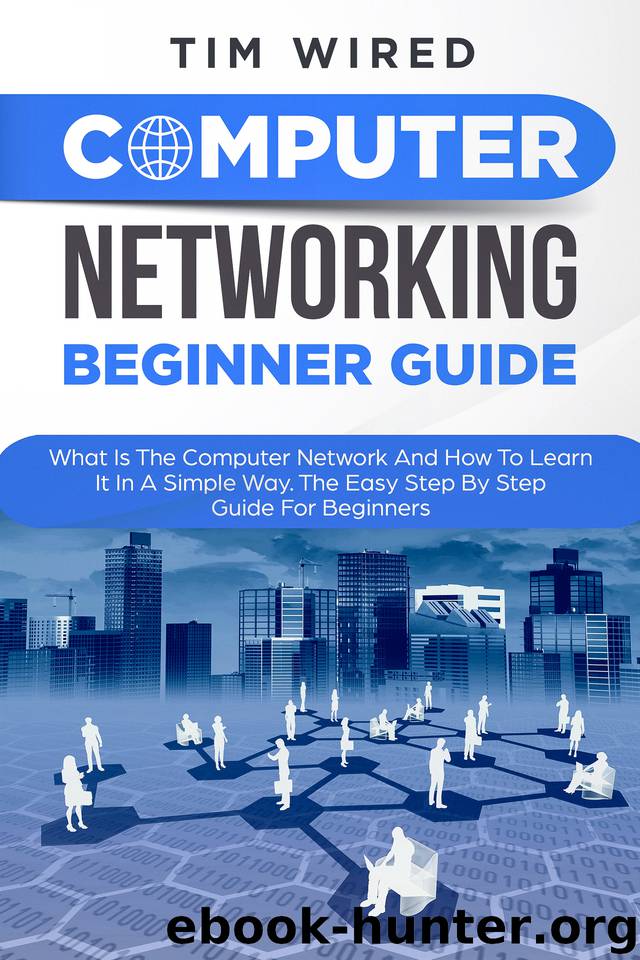Computer Networking Beginners Guide: What Is The Computer Network And How To Learn It In a Simple Way? The Easy Step By Step Guide For Beginners (programming Book 3) by Wired Tim

Author:Wired, Tim [Wired, Tim]
Language: eng
Format: epub
Published: 2019-11-09T16:00:00+00:00
Wireless LAN (Local Area Network)
This is a network where there are two or more computers or devices connected to the network and it only covers a limited area, for example a home or small business. The NIC is sed in this type of network, we often call this the Peer-to-Peer Network (P2P). Another form of this is an ad-hoc network which is used in temporary manner.
Unlike using switch in a wired network, in the WLAN setup we use a device called an access point. This is a central device from which the RF signal is being generated. WLAN which uses access point are called Basic Service Set (BSS), it acts as the coordinator between different devices within the network.
Wi-Fi
RF signal Frequency: 2.4 GHz or 5 GHz
Range: 100 meters
Wi-Fi products are certified and tested by the Wi-Fi Alliance
Wireless MAN (Wireless Metropolitan Area Network)
Collected unit of many WLANs located at various places
Uses WIMAX technology (Worldwide Interoperability for Microwave Access) which is controlled by WiMAX Forum
Maximum Speed: 1 Gbits/ sec
IEEE 802.16 Standard
WWAN (Wireless Wide Area Network)
This is an extensive network that has been distributed across an immense amount of space. It connects cities together. Mobile phones use WWAN to make communication possible.
The technology in WWAN are subdivided in generations: 2G, 3G, and 4G
Most analog devices are utilizing this technology
· Examples of 2g
- General Packet Radio Service (GPRS)
- Enhanced Data rates for GSM Evolution (EDGE)
· Examples of 3G (third generation technologies)
- Code Division Multiple Access (CDMA)
- Universal Mobile Telecommunication System (UMTS)
- High Speed Packet Access (HSPA)
- Evolved High Speed Packet Access (HSPA+)
· 4G (High Speed Network accessibility can be achieved with this technology)
- Long Term Evolution (LTE)
- Voice Over Long-Term Evolution (VoLTE)
Time Evolution
In 1G in the 2980s, the only single voice was going from one device to another device. The analog protocol was being utilized during this period. In mid 1980s 2G network has introduced, with it came voice and text capabilities. Both voice and text messages are going from one device to another device with the use of digital standards. The speed from 1G (2.4 kbps) has increased when 2G was invented (16 kbps). In 2003, 3G has evolved from voice and text, with now including data. It uses the multimedia technologies and has a speed of up to 2 Mb per second. In 2009 4G was introduced to the market, this technology allows voice to go through data. IP protocol is utilized, and the speed can reach up to 100 Mb per second. 5G technology is the next one to hit the market soon, it will have more bandwidth mobility which a key factor for it would be to succeed.
WPAN (Wireless Personal Area Network)
This kind of network is used smaller distance
Technologies that are mostly used for WPAN are Bluetooth and Infrared Data Association
Bluetooth
· Uses ISM band of 2.4 GHz
· Speed of up to 721Kbps
· Range goes anywhere between 10 to 100 meters
If you are using Bluetooth technology, let’s say in your headset or keyboard or speakers and it is connected to your
Download
This site does not store any files on its server. We only index and link to content provided by other sites. Please contact the content providers to delete copyright contents if any and email us, we'll remove relevant links or contents immediately.
Kotlin in Action by Dmitry Jemerov(13440)
Grails in Action by Glen Smith Peter Ledbrook(12981)
Sass and Compass in Action by Wynn Netherland Nathan Weizenbaum Chris Eppstein Brandon Mathis(11620)
Azure Containers Explained by Wesley Haakman & Richard Hooper(7488)
Configuring Windows Server Hybrid Advanced Services Exam Ref AZ-801 by Chris Gill(7472)
Running Windows Containers on AWS by Marcio Morales(7025)
Microsoft 365 Identity and Services Exam Guide MS-100 by Aaron Guilmette(5423)
Microsoft Cybersecurity Architect Exam Ref SC-100 by Dwayne Natwick(5263)
Combating Crime on the Dark Web by Nearchos Nearchou(5004)
The Ruby Workshop by Akshat Paul Peter Philips Dániel Szabó and Cheyne Wallace(4693)
Management Strategies for the Cloud Revolution: How Cloud Computing Is Transforming Business and Why You Can't Afford to Be Left Behind by Charles Babcock(4532)
Python for Security and Networking - Third Edition by José Manuel Ortega(4254)
The Age of Surveillance Capitalism by Shoshana Zuboff(4218)
Learn Wireshark by Lisa Bock(4167)
The Ultimate Docker Container Book by Schenker Gabriel N.;(3910)
Learn Windows PowerShell in a Month of Lunches by Don Jones(3908)
DevSecOps in Practice with VMware Tanzu by Parth Pandit & Robert Hardt(3596)
Windows Ransomware Detection and Protection by Marius Sandbu(3565)
Blockchain Basics by Daniel Drescher(3514)
